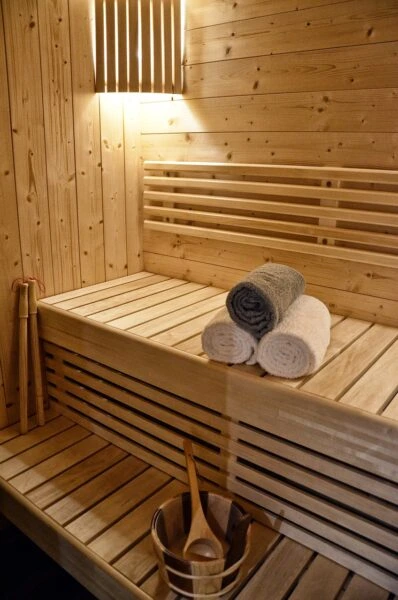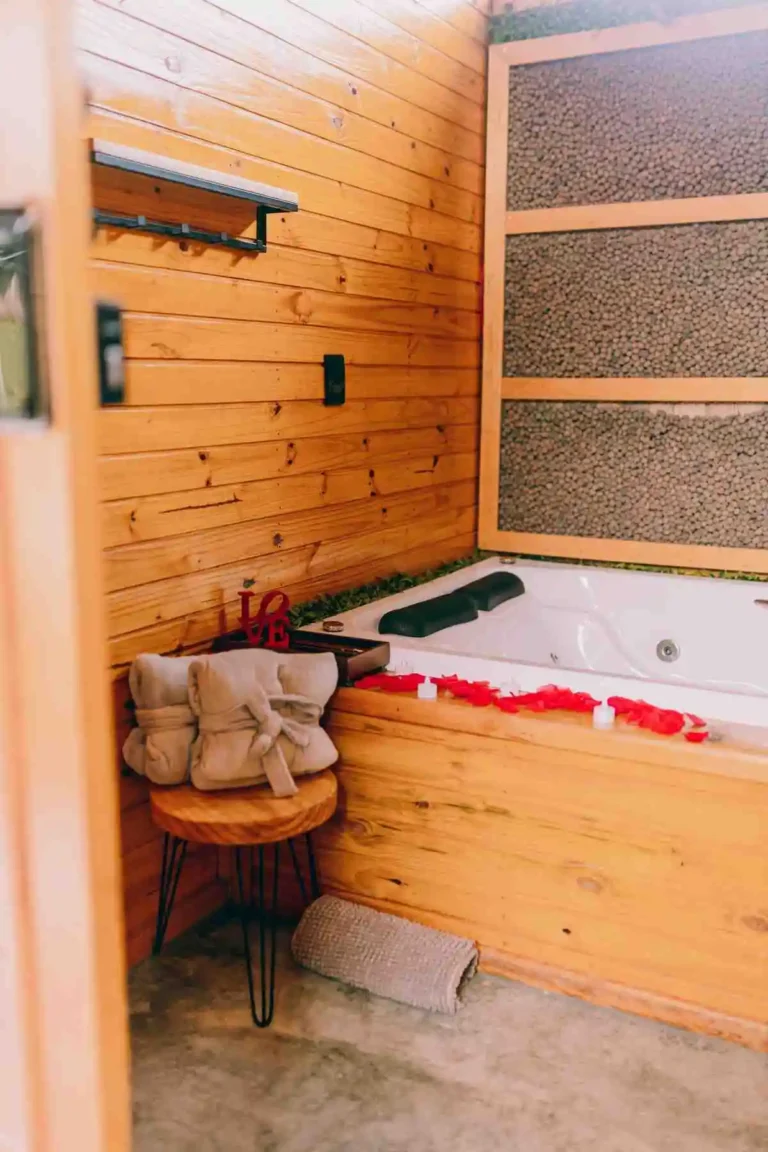What to Wear in a Sauna: Essential Tips for Proper Attire
What to wear in sauna depends on balancing comfort, hygiene, and performance. Opt for lightweight, breathable fabrics like cotton towels or wraps—they allow skin to breathe, absorb sweat efficiently, and maintain modesty without compromising the sauna’s therapeutic benefits. This simple choice ensures you get the most from your session.
If you’re looking to cover up a bit more, go for natural fibers that are nice and loose-fitting. Cotton T-shirts and shorts are perfect because they help heat escape. Footwear and tight-fitting apparel are a no-go, as they disrupt the ability to relax and flow freely with the heat.
Most saunas allow swimsuits as well, but choose something loose-fitting with breathable fabric. It’s good to know what’s allowed in your private or public sauna. Whether it’s clothing, a towel, or a blanket, each decision adds to a relaxing and effective sauna experience.
What to Wear in Sauna? Appropriate Attire Guidelines
Knowing what to wear to the sauna will help make your time there both comfortable and respectful. What kind of clothing you wear—or don’t wear—can vary based on what type of sauna you’re using, cultural traditions, and your personal preferences.
To ensure you have the best sauna experience, consider comfort, hygiene, and etiquette when choosing what to wear.
1. Prioritize Comfort and Safety
That’s because the heat in a sauna is no joke. Opt for clothing that allows your body to sweat and cool down as needed. Loose-fitting items with cotton or bamboo fabrics are best for improved breathability.
Tight clothes, like leggings, may limit mobility and add extra warmth, making you unnecessarily hot. Avoid clothing with metal components or synthetic material that could respond to the heat and lead to irritation or burns.
2. What to Wear in a Sauna Based on Sauna Type
Each type of sauna is distinctive in its own right. Many traditional dry saunas, like those in Finland, promote little to no clothing and full nudity. Conversely, steam rooms usually call for thinner swimwear due to the intense levels of humidity.
American facilities tend to push for bathing suits or towels, while in Germany and Austria, nudity is the norm. As always, be sure to adjust according to the sauna’s environment and intent—be it relaxation or detoxification.
3. Consider Hygiene and Health Factors
Wearing clean clothing that wicks away sweat is ideal for keeping attics and fabrics fresh, particularly in shared environments. Showering before sauna use provides a fresh start and reduces bacteria.
Swimwear or a towel used in saunas is common. Public baths in many cultures use lava rock saunas, towels, or modest swimsuits for hygiene and modesty. Leave behind sweaty workout clothes, which can spoil the environment for everyone.
4. Respect Cultural Sauna Traditions
In Finland, it’s common to be naked, whereas the U.S. Culture is more in favor of covering up. Know that these variances exist and try to make choices that best fit local cultural norms to ensure the comfort of others.
Clothing Options for Sauna Use
Whether you take a sauna for relaxation, recovery, easing joint pain, or another reason, the right sauna clothing choices can help maximize your comfort and enjoyment. Ultimately, what you wear should be a reflection of your own personal comfort, practicality, and the appropriate cultural or social sauna environment.
Below, we break down some options and considerations to find the best fit for you.
Towels: A Versatile Choice
Towels are a simple, practical, and effective solution. Besides hygiene, covering one’s body and ensuring comfort after walking in the sauna, they have other practical uses.
Wrapping a towel around your body introduces another layer of modesty, which is useful if you are using a public sauna. Cotton towels are overall the best option with both their softness and absorbency, making sure you’re comfortable, sweating away.
Be sure to bring at least two towels. Use one to sit on and the other to wipe off sweat, keeping you clean and fresh throughout your sauna session.
Swimwear: When and How to Choose
Swimwear is a great, hygienic, functional option, especially for use in mixed-gender or public sauna settings. Choose swimwear that’s lightweight and made of natural fibers, like cotton, that won’t trap heat and will let your skin breathe.
Steer clear of materials such as PVC, which will actually melt and emit dangerous toxins in high-heat environments. Additionally, avoid suits with metal components that can get hot and lead to burns.
Loose-fitting swimwear is a better option to allow your body to cool off and be comfortable.
Loose-Fitting Clothing: Comfort First
Loose, breathable fabrics allow for great air circulation while wicking sweat from your body. These ultralight fabrics are flowy and breathable to keep you airy, never weighed down by heat.
Clothing that fits tightly, such as leggings, should be eliminated, as they limit your mobility and air circulation, which can lead to an uncomfortable experience.
Minimalist Approach: Is it Right?
Most regular sauna users choose to wear little clothing—or none at all—to sweat freely and relax completely. In countries such as Finland, nudity is the norm and widely accepted, but you should do what you are comfortable with.
Nudity or minimal clothing promotes your skin to sweat more effectively, improving the sauna’s benefits.
What to Wear in a Sauna: Men’s Guide
Choosing appropriate clothing for a sauna visit is important for comfort and air circulation, as well as getting the most out of sweating. Opt for fabrics and styles that allow for good breathability and airflow. Whatever you wear, be sure it protects modesty and hygiene as well. Below, we provide our take on the best options to look for and look to.
Shorts: Selecting the Right Pair
Choosing the right shorts makes all the difference in your sauna experience. Opt for natural fibers such as cotton or linen. They help with air circulation and sweat absorption. Shorts made of cotton, for instance, offer modesty without overheating you.
These considerations noted, lightweight swim trunks in synthetic fabrics are a no-brainer. Since they have no metal fasteners, they can’t heat up and burn you. Go for comfort and fit. Always choose sauna shorts with a comfortable, non-restrictive fit to ensure breathability and movement.
Stay away from heavy fabrics such as denim or extremely thick athletic materials, which can lead to heat retention and feel constraining. A cotton tank top and shorts make a high-quality sauna-ready ensemble. Lightweight swimwear is a perfect combination of style and function.
Towel Wrap: A Classic Option
For most, a towel wrap provides the easiest, most versatile option. Since a large cotton towel is highly absorbent and gives full coverage, it is one of the most hygienic options to wear in a sauna. Wrapping it securely around the waist ensures it won’t slip off, even if you’re walking or adjusting your position on a sauna bench.
A towel gives your skin space to sweat, which is essential for the sauna’s detoxifying benefits. Interestingly, in Finland, where saunas are a cultural staple, over 80% of sauna-goers either wear a towel or go nude. This choice is both traditional and practical.
Footwear: Protecting Your Feet
Footwear is an important topic to discuss. Shower sandals are the best choice for going in and out of the sauna on slippery, wet floors. Shoes need to come off as you enter, as this helps keep the space clean.
Going barefoot in the sauna is usually a good idea for a more authentic, comfortable experience. While it’s not required, if you prefer to wear something on your feet, stick to something light that you can easily take off.
What to Wear in a Sauna: Women’s Guide
In essence, when planning what to wear in a sauna, your priority should be comfort and breathability. Choosing the right sauna attire improves your sauna experience by making you feel cooler and comfortable while considering personal and cultural preferences. Your choice will depend on what type of sauna it is, if it’s private or public, and what you might feel most comfortable with.
Swimsuits: Styles and Considerations
In most public saunas, swimsuits are very normal, even expected. Lightweight, breathable, natural fabrics like cotton blends are your best bet since they help improve air circulation and absorb sweat. Don’t wear swimsuits made from synthetic or PVC materials, which prevent heat from escaping and can feel suffocating.
Eliminate any metal elements, such as underwire and decorative elements. They can overheat and cause heat-related illness. A simple, non-bolted one-piece or a two-piece bikini works wonderfully for most women, providing enough coverage while still being practical.
In predominantly black, integrated spaces such as the communal bathhouses in the U.S., people often adhere to swimsuit norms. Yet in Finland, people, to a degree, learn to accept nudity as an organic part of their sauna practice.
T-Shirts and Tank Tops: Breathable Layers
Loose-fitting tees or blouses in cotton or linen work great as well. These fabrics are breathable, lightweight, and one of the most effective at absorbing body moisture. Tight clothing, such as leggings, or thick synthetic fabrics, should not be worn as they can retain heat and limit air circulation.
Cotton tank tops and shorts are comfy, casual, and easy to get on and off. This outfit is perfect for use in private sauna environments.
Hair Covering: Protecting Your Hair
Protecting your hair from heat damage should be a priority. A sauna hat or breathable cotton headband will protect your scalp and keep your hair out of the way. To ensure you’re comfortable, keep your hair tied up so you can avoid sweating too much.
This method is especially useful in public saunas where cleanliness is a concern.
Choosing the Right Material for What to wear in Sauna
Choosing the correct material for sauna clothing is important for ensuring that you’re comfortable and enjoying the experience while prioritizing safety. Breathability, moisture-wicking, and heat resistance are important factors in creating a relaxing environment. Each material is exposed to a different interplay of high heat and humidity. What you can choose makes all the difference.
Natural Fabrics: Benefits and Examples
Natural materials like cotton, linen, and bamboo are especially effective during sauna sessions. They allow for greater air movement, keeping your skin ventilated and comfortable.
Cotton is extremely popular, and for good reason—it’s unbelievably soft. Second, it wicks moisture away from skin, which helps to prevent chafing as you sweat. Linen, with its extraordinarily quick-drying qualities, is a great choice, particularly in damp climates.
Rich bamboo fabrics bring an extra sense of luxury, providing maximum breathability and a silkiness that feels great during restorative stretches or deep relaxation. Since these materials help the body maintain an even temperature, they are beneficial in allowing the sauna to be very hot.
Try out various natural materials to see what best adheres to your unique needs and is the most comfortable on your bare skin.
Synthetic Fabrics: Why to Avoid
Materials like polyester and nylon, which are synthetic, are not as good for sauna wear. These porous fabrics keep in both heat and moisture, making you uncomfortable with trapped air flow.
When synthetic fibers are subjected to extreme heat, they can discharge toxic chemicals, which may lead to serious health risks. Woven fabrics are not moisture-wicking, so more sweat can pool on your skin.
Choosing natural replacements cuts down on these issues and helps improve your sauna experience overall.
Fabric Performance: Heat and Moisture
How well your sauna clothing works and how comfortable it is while you’re working out all starts with how the fabric manages both heat and moisture. Natural fabrics are best in high temperatures as they wick sweat away from your body and promote breathability.
This naturally reduces stickiness and discomfort even on hot sauna benches. By testing out different materials, you can find one that meets your desired level of comfort and purpose without excessive heat retention.
Essential Sauna Accessories
When setting up for a sauna session, using the best sauna accessories will make your experience more comfortable and hygienic. Whether it’s taking control of your sweat or enjoying the benefits of hydration, these accessories improve the experience and make your time in the sauna even better.
Below, we’ve put together some sauna accessories must-haves to keep in mind and make the most of them.
Towels: Absorbency and Comfort
- Towels – Towels are a must in any sauna. A stylish, high-absorbency cotton towel is perfect for soaking up all that sweat without irritating your skin.
It’s a good idea to bring two towels—one to sit on, one to dry off with when you exit your session. Since proper sauna hygiene etiquette requires you to use a towel or bathrobe, it’s important to have extra towels on hand so you’re always prepared.
Get larger towels that size up to provide full body coverage and smaller hand towels that you can use to wipe a sweaty face or hands.
Water Bottle: Staying Hydrated
Saunas can be very dehydrating on your body, so it’s definitely important to enter the sauna with a water bottle. Choose a reusable, insulated bottle for water that stays cool and refreshing during your whole sauna session.
Take regular sips of water beforehand, during, and after your sauna session to stay hydrated. This easy addition can really tip the balance of your sauna experience in making you feel great when you’re done.
Headwear: Protecting Your Hair
A sauna hat is a kind of gift as it helps guard your hair from extreme heat and humidity. Choose breathable materials, such as cotton or wool, to keep you comfy without overheating.
For ease of use, pull your hair away from your face so that it’s out of the way and not retaining moisture. If you’re using a public sauna, keeping your sauna headwear as clean as possible by regularly washing or sanitizing it becomes imperative.
Footwear: Hygiene and Safety
Shower sandals or other lightweight flip-flops are perfect for keeping you safe from slips on wet surfaces outside of the sauna. It’s traditional to take off your shoes before entering, to keep things clean.
Others feel most comfortable going barefoot, as it provides a more traditional sauna experience.
What Not to Wear in a Sauna
It’s important to know what not to wear in a sauna in order to create the most comfortable, safe, and hygienic environment possible. Familiarizing yourself with these dos and don’ts will ensure you get the most out of your sauna experience while safeguarding your health.
Tight Clothing: Restricting Airflow
So, wearing tight clothing in a sauna is both uncomfortable and counterproductive. These contraptions prevent proper airflow and keep your body from being able to sweat naturally. Understandably, this limitation would be quite the bummer on your sauna experience.
While sweat is your body’s cooling mechanism, clothes that are too tight can prevent sweat from evaporating, putting you at risk an overheating. Loose-fitting options, such as lightweight towels or breathable swimsuits, provide greater airflow and comfort.
Cleveland Clinic cautions that wearing heavy or dark clothing can lead to heat-related conditions, like cramps or heat exhaustion. To put it simply, it’s just better to avoid these kinds of clothing completely.
Makeup and Lotions: Skin Health
Makeup and lotion can clog your pores while using a sauna. This irritation happens when these products interact with your sweat. It makes sense since saunas really do open those pores, so going in with clean skin is important.
Taking off makeup ahead of time lets your skin breathe, and not applying lotions cuts out extra product buildup. After your session, stick to gentle cleansers to help rinse away sweat and impurities.
By putting the emphasis on hydration and natural skincare ingredients, you can promote truly beautiful, healthy, awakened skin.
Jewelry and Piercings: Avoiding Burns
When placed in high heat, metal quickly heats up and could cause burns or discomfort. Even tiny items such as rings or earrings can get dangerously hot.
To be safe, take off all jewelry and leave valuables outside. This precaution avoids potential irritation and helps you enjoy the sauna worry-free.
Sweaty Gym Clothes: Hygiene Concerns
Make sure your sweaty workout clothes are not what you’re wearing in a sauna. They can accumulate bacteria and cause bad smells, compromising your comfort.
Something clean and dry, like a 100% cotton swimsuit or towel, is a better choice. In many culturally appropriate considerations, many saunas in the U.S. Where bathing suits/towels are required, it is customary to shower on the way in for hygiene.
Finns often sauna naked, but if that’s not your preference, fresh clothes are essential for a pleasant and sanitary experience.
Sauna Etiquette and Hygiene Practices
Learning the ins and outs of sauna etiquette is important to providing a relaxing and pleasant atmosphere for all guests. Everyone else who enjoys the sauna will appreciate your attention to basic hygiene and etiquette, creating a more pleasurable atmosphere for your sauna experience.
Respecting Personal Space
With limited space being so important in the close quarters of a sauna, it’s especially vital to respect personal space. Make sure to always provide adequate spacing between yourself and others, particularly where it may not be easy to find other seating.
Respect other people’s space—don’t crowd or sit as close to someone unless they’ve invited you to do so. Consider other people’s comfort level. Keeping your distance from everyone else means avoiding unwanted physical contact and respecting everyone’s personal space.
This encourages a respectful environment where all can relax without feeling awkward or imprisoned.
Maintaining Cleanliness
Proper sauna etiquette begins long before you enter the sauna. By showering first, you’ll rinse off all oils and dirt that have accumulated on your skin. Doing this helps the shared space remain more hygienic for all guests.
Once inside, sit on a towel to prevent sweat from transferring onto the benches, and always bring a clean towel for this purpose. Wearing lightweight, loose-fitting clothing materials such as cotton or linen can further improve comfort levels and minimize skin irritation from heat.
After your sauna session, wash your face with a gentle cleanser. This will keep you from forming bumps from the clogging of sweat. Finally, make sure to dispose of garbage or personal items when you’re done to help maintain a clean environment.
Being Mindful of Others
Saunas are intended to be peaceful, meditative environments, so please be mindful of your sound disturbances. Stay off phones and avoid loud discussions or rowdy behavior that might disrupt the other guests.
Limit personal belongings to avoid clutter and keep shared spaces usable. Part of being considerate of other guests is being aware of what the established sauna rules are—like clothing requirements—and following them.
If nudity is the norm, just make sure the sauna environment matches your comfort level before joining in.
Footwear Choices for Saunas
Footwear choices before and after a sauna session are very important for both cleanliness and safety. It makes it a more enjoyable thing to do. With all the benefits they provide, saunas are a perfect place to relax and unwind! Making a conscious choice about your footwear can make all the difference in the world. From safeguarding you from the hot ground to avoiding accidents, here’s everything you should consider.
Protecting Feet from Heat
Open-toed sandals or flip-flops will protect your feet from hot surfaces when not in the sauna. They’re particularly effective around paved paths and tiled surfaces that absorb direct sunlight. Walking without shoes in public spaces can expose the feet to cuts and abrasions.
You can be susceptible to deep lacerations or thermal burns, particularly on abrasive or hot surfaces. Comfortable foam or rubber sandals are lightweight, and they’re easy to slip off and on. They help make smooth and easy transitions to and from the sauna effortless!
Be careful about inching into or out of the sauna! This is due to the fact that the wood and tile floor surfaces retain heat, which can become dangerous and uncomfortable for your feet.
Preventing the Spread of Germs
When everyone has their shoes to wear in a communal area, the chances of spreading germs are significantly lowered. Shower sandals, for example, provide a protective layer between your feet and bacteria-ridden surfaces.
Prevent bringing in dirt and bacteria by not wearing outdoor shoes in sauna spaces. Keeping personal items and footwear, such as sauna sandals, tucked away when not being worn, helps eliminate cross-contamination.
Many facilities have strict rules regarding footwear, so following these regulations will help keep a safe, hygienic facility for all users.
Selecting Slip-Resistant Options
Additionally, slip-resistant sandals with textured or rubber soles help prevent slipping in wet areas, like showers or near pools. Crombie says that footwear with a non-slip grip can help lower the risk of falls, particularly on slippery tile or wood floors.
Lightweight, easy-to-remove styles are the most practical choice for sauna use—something heavy or bulky on the feet will be uncomfortable. By being mindful of what type of flooring is in the sauna, you will be able to choose footwear that allows you to be comfortable while maintaining footing.
Jewelry and Piercing Considerations
When preparing for a sauna session, it’s essential to consider how jewelry and piercings interact with high heat and humidity. The sauna setting has its own specific challenges and hazards, so it is very important to keep your safety and comfort as the highest priority.
Potential for Overheating
Jewelry, especially metal pieces, can heat up fast in the sauna, risking burns or unpleasant sensations. Rings, necklaces, and bracelets are particularly vulnerable to getting hot because they remain in constant and close contact with your skin.
Overheating can lead to heat stress, which can cause dizziness, nausea, or other feelings of illness. If you start to feel too hot or begin showing symptoms of heat stress, taking off jewelry right away can be vital.
It allows your body to cool more effectively and prevents overheating. That way, you can get the most out of your sauna sessions as safely and enjoyably as possible.
Risk of Skin Irritation
The heat and moisture from a sauna can make it easier for your jewelry to rub against your skin, causing friction. This often leads to irritation.
For instance, tight-fitting rings or necklaces that move with the motion of the body can rub against sensitive skin, leading to irritation or redness. Additionally, sweat can react with metals/alloys that can cause allergic reactions and/or pieces turning green.
Nickel and other similar materials are well known for causing these types of problems, so it’s wisest to keep these items at the door. Prioritizing your skin’s health in this environment means avoiding anything that could irritate or react poorly with heat and sweat.
Safe Removal Practices
To avoid burning or losing them, take off any jewelry and piercings before going into the sauna. Bring jewelry and piercing considerations into focus.
Use a secure locker or other designated storage space to keep valuables safe and secure. If the facility has specific policies regarding personal items, adhere to them in order to prevent losing them.
By taking these precautions, you can make sure your thoughts stay on rest and rejuvenation instead of wandering to thoughts about safety or security.
How to Maximize Your Sauna Experience
While relaxation and health benefits await you in the sauna, preparing yourself beforehand and being mindful during your sauna session can enhance your enjoyment even further. By paying attention to your hydration, time management, and cleanliness, you can maximize your sauna experience in enjoyment and health benefits.
Stay Hydrated Before, During, and After
Hydration—Before, during, and after a sauna session, hydration is key! Staying hydrated is important in helping your body get acclimated to the heat. Keeping a water bottle handy will make it easier to hydrate as needed, which is extremely important during longer sauna sessions.
Rehydrate afterward to prevent dehydration. After your sauna session, replenish the fluid you lost through sweat. If you are in a sauna for 15–20 minutes, make sure to drink 16–20 ounces of water afterwards. This allows your body to get back on the path to healing.
Listen to your body—when you start to feel thirsty or light-headed, it’s an indication that you should drink more fluids.
Limit Time to Prevent Overheating
Time spent in the sauna is pretty critical! Shorter sessions, like 10–15 minutes in length, are great for newcomers. Increase the time incrementally as your body adjusts. Having a timer set means you won’t accidentally overstay your welcome.
If you become dizzy, fatigued, or overheated, it’s time to leave and cool down. Make comfort the priority, not endurance, and pay attention to your body and don’t expose yourself to heat that feels too extreme.
Shower Before Entering the Steam Room
If for no other reason, a quick shower before entering the sauna should be standard for a few reasons. Removing your sweat and dirt will maximize sauna cleanliness, ensuring a fresh and clean sauna environment for all users.
Providing a barrier of protection from the heat and perspiration, a mild cleanser helps to defend against irritation as well. A lot of facilities suggest or even ask you to shower first.
Keeping in mind, this practice will make for a clean and enjoyable sauna experience.
Conclusion
Sauna time is an opportunity to get comfortable, unwind, and focus on taking care of your body. Wearing the right clothing and materials is important in determining how enjoyable of an experience you will have. Lightweight, breathable fabrics such as cotton or linen will help you stay cool and allow your skin to breathe. Towels around your waist, around your neck, beneath you, or on your head, accessories keep you comfortable while keeping you cool and hydrated. Being mindful of hygiene and selecting appropriate footwear makes for a more comfortable and respectful experience.
Whether it’s clothing, jewelry, or other accessories, every decision you make contributes to a more soothing sauna experience. Experience the difference. Stick to what’s natural, and feel the difference. With these tips in hand, you’re ready for a comfortable and rejuvenating sauna experience.







